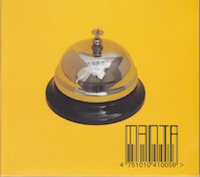In the history of Latvian alternative music, the group Hospitāļu iela remains one of the brightest stars. With their combination of varied musical styles, offbeat lyrics, and general quirkiness, songs such as ‘Par Pogu’ and ‘Par Raimi’ became hits. However, after their third album, 2007’s Pūķis, the group went on extended hiatus, and officially broke up in 2010 (though their final performance was in 2011). The group’s leader and songwriter Edgars Šubrovskis remained active in various projects (most notably the band Gaujarts and 2014’s tribute to Māris Šverns and Baložu pilni pagalmi – Brāļi un māsas), and now has a new project entitled Manta, who released their debut album Ansamblis Manta in 2014.
Along with Šubrovskis (on guitar, bass guitar and vocals), Manta’s other members are Edgars Mākens on organ, stylophone, and backup vocals, as well as Oskars Upenieks on synthesizers, samples and backup vocals, and Raitis Viļumovs on percussions and backup vocals.
The immediately noticeable difference between Manta and Hospitāļu iela is that keyboards are now a significant part of the sound, giving Manta a more electronic sound. The presence of the synthesizers gives the music a strong resemblance to Latvian electronic music pioneers Dzeltenie pastnieki – which may not be completely coincidental, considering that the producer of the album is one of Dzeltenie pastnieki ‘s founders Ingus Baušķenieks. The electronic flavor of the music gives the songs an additional creative dimension, allowing for more experimentation and creativity. Additionally, the presence of the electronic music is not overbearing, and is well balanced with the rest of the instruments.
With the first track, ‘Viva Voleros’, Manta define themselves as subdued, but intense performers. Šubrovskis’ picturesque lyrics relate views of the Voleri area of Riga – an area of abandoned factories, ports, and small gardens, with a variety of inhabitants, many of whom look suspiciously on unfamiliar visitors. The unease of an outsider visiting Voleri is reflected in the lyrics – ‘Kā tu domā, kā es te izskatos?’ (How do I look here, what do you think?)
The songs at times have images of fleeing and alienation, such as the song ‘Suņi seko’, which tells the story of a search for a fugitive shooter, while at the same time appearing to be an allegory for trying to find someone that cannot be found, with bitter memories. The plight of the fugitive is summed up with the song’s central lyric – ‘Vientuļa bēgļa vienīgais draugs ir nikotīns’ (The only friend of a lone fugitive is nicotine).
Manta provide their own variation on the Latvian legend of Kristaps, entitled ‘Antikristaps’, where the devil curses Kristaps to carry a child over the Daugava RIver, only to find the child getting heavier and heavier, until Kristaps, having reached the middle of the river, sinks. The slow and plaintive vocals, sung over a simple and deliberate electronic beat, give the song an eerie, atmospheric feel.
The slow, wistful ‘Tūkstošreiz’ closes the album. As with many of the songs of the album, the lyrics appear to be about travels to lesser known or unusual places – there is a sense of searching for something that cannot be found, a feeling of solitude and loneliness – ‘tur, kur kādreiz es braucu tūkstošreiz, bet nu arvien retāk’ (Where I used to go a thousand times, but nowadays rarely).
As was often the case with Hospitāļu iela, the lyrics can be a bit opaque from time to time. Interestingly, the group chose to include English translations of all the lyrics in the booklet – though that does not always help determine what the song was about!
It would always be a challenge to follow up on the success of Hospitāļu iela, which was one of the most popular and influential alternative bands in recent Latvian music history. Instead of copying previous successes, leader Edgars Šubrovskis takes things in a new direction, and with successful results. Manta has released an impressive debut album – it is not much of a surprise that Ansamblis Manta was awarded the Latvian Great Music award for best alternative album in 2014. Featuring quirky and intriguing lyrics, engaging music, Manta distinguish themselves from other alternative groups with their creativity, and have made a memorable album.
For further information, please visit Manta’s Facebook page.
Details
Manta
Ansamblis Manta
Produced by Biedrība HI, 2014
Track listing
- Viva Voleros
- Pastaigajos, nerunajos
- Antikristaps
- Jasmejas kopa
- Pred Plus
- Milicis
- Adita veste
- Mazie un lepnie
- Suni seko
- Nave juras mala
- Tukstošreiz





